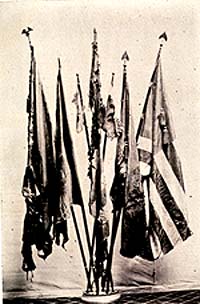The Calvin Shedd Papers > Seventh Regiment, New Hampshire Volunteers
Seventh Regiment, New Hampshire Volunteers
Lt. Colonel Joseph C. Abbott raised the regiment in Manchester, New Hampshire. Governor Berry appointed Colonel Haldimand Sumner Putnam, an experienced army officer, to command the regiment in October, 1861. On January 16, 1862, the regiment left New Hampshire for four weeks of drill in New York City. Among the many New Hampshire men in uniform was Calvin Shedd. The Seventh Regiment was dispatched to the Dry Tortugas, a lonely, desolate island on the far end of the Florida Keys. This sub-tropical strip of land served as the principal depot for the distribution of rations and munitions to the forts and military posts in the South. Shedd traveled to Florida with a portion of the regiment on board the ship Tycoon. This vessel served as an incubator for debilitating and deadly diseases transported from the unsanitary camp conditions of New York City. A second vessel, the Mallory, transported another portion of the regiment. While stationed in Key West, the regiment spent time unloading cargo transport ships, improving the fortifications at the post, performing drills, and standing guard duty. In their seemingly endless spare time, the men hunted bird and turtle eggs, collected shells, and explored nearby islands. After three and a half months at Fort Jefferson, the regiment was ordered to Beaufort, South Carolina. While stationed in South Carolina, the health of the regiment worsened. It is possible that a few cases of yellow fever broke out on the ship Ben Deford. The disease began to appear in Key West about the time the regiment stopped there on its way north. At the end of August, the regiment was ordered to St. Augustine to relieve four companies of the Fourth New Hampshire, who were garrisoned there. Military officials thought that St. Augustine was the healthiest post in the south and the Seventh was deemed unfit for duty. The regiment lost over 200 men to death and discharge since leaving Manchester. St. Augustine proved to be a pleasant post for the Seventh Regiment. Members of the regiment regained their health and new recruits were added. There was very little rebel activity near St. Augustine, so the regiment was able torest and recuperate. Soldiers performed guard and picket duty, practiced target shooting, and patrolled the city. Shedd had remained behind in Beaufort, South Carolina due to illness, but he rejoined his regiment along with Colonel Putnam at the end of September, 1862. In April, 1863, the regiment was ordered to Fernandina, Florida, but its stay there was very brief. On June 5, 1863, Colonel Putnam was ordered to bring his regiment to Hilton Head, South Carolina, on board the steamer Boston. The Seventh Regiment was then ordered to Folly Island and made camp. In early July, the regiment took the rebel forces on Morris Island by surprise and battled to take the south end of the island. The batteries on the south end of Morris Island were taken and within hours two-thirds of the island was captured. On July 17 and 18, the regiment took part in the two ill-fated assaults on Fort Wagner. In the second assault, the Seventh lost over 216 men, including Colonel Putnam and several other officers. Shedd was not among the casualties, as he had taken ill again and did not participate in the assault. During the remainder of 1863 and throughout 1864, the Seventh New Hampshire took part in a number of sieges and battles. Many of the members of the regiment were lost in the Battle of Olustee, Florida, in February, 1864. The regiment then took part in engagements in Virginia and North Carolina. The regiment received final discharge and pay on August 8, 1865, and the Seventh Regiment New Hampshire Volunteers was disbanded.
 Bibliography: Boatner, Mark M. The Civil War Dictionary. New York: David McKay Company, Inc., 1959. Faust, Patricia L., ed. Historical Times Illustrated enclclopedia of the Civil War. New York: Harper & Row, 1986. Fort Jefferson and its Commander 1861-2. Reprinted from Journal Military Service Institution. New York: Governor's Island, 1910. Fretwell, Jacqueline, Ed. Civil War Times in St. Augustine. St. Augustine, Florida: St. Augustine Historical Society, 1986. Little, Henry F. W. The Seventh Regiment New Hampshire Volunteers in the War of the Rebellion. Concord, New Hampshire: The Seventh New Hampshire Veteran Association, 1896. Schmidt, Lewis G. The Civil War in Florida: A Military History. Vol I: Florida's East Coast, Vol III: Florida's Key's & Fevers. Allentown, Pennsylvania: L. G. Schmidt, 1989. Waite, Otis Frederick Reed. New Hampshire in the Great Rebellion. Containing Histories of the Several New Hampshire Regiments, and Biographical Notices of Many of the Prominent Actors in the Civil War of 1861-1865. Claremont, New Hampshire: Tracy, Chase & Company, 1870. Warner, Ezra J. Generals in Blue: Lives of the Union Commanders. Baton Rouge: Louisiana State University Press, 1964. Warner, Ezra J. Generals in Gray: Lives of the Confederate Commanders. Baton Rouge: Louisiana State University Press, 1959. |
